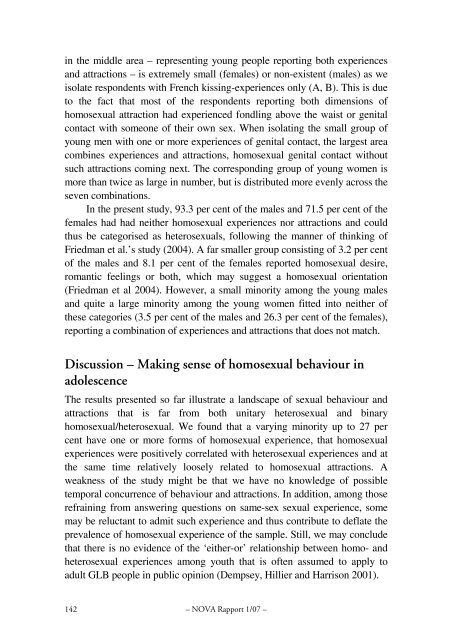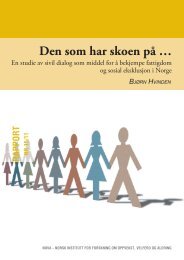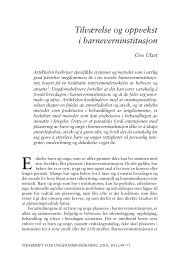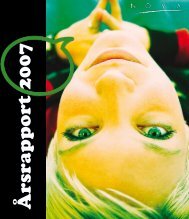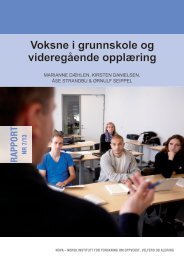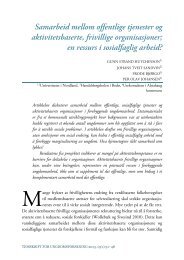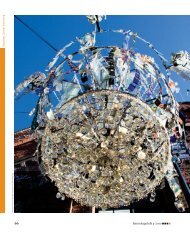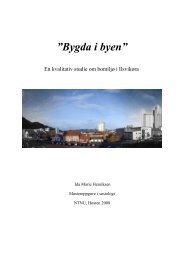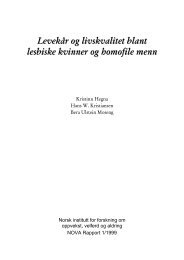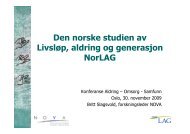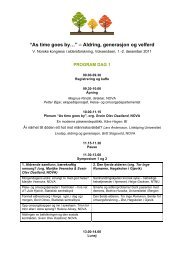Betydningen av seksuell erfaring, tiltrekning og identitet for ...
Betydningen av seksuell erfaring, tiltrekning og identitet for ...
Betydningen av seksuell erfaring, tiltrekning og identitet for ...
You also want an ePaper? Increase the reach of your titles
YUMPU automatically turns print PDFs into web optimized ePapers that Google loves.
in the middle area – representing young people reporting both experiences<br />
and attractions – is extremely small (females) or non-existent (males) as we<br />
isolate respondents with French kissing-experiences only (A, B). This is due<br />
to the fact that most of the respondents reporting both dimensions of<br />
homosexual attraction had experienced fondling above the waist or genital<br />
contact with someone of their own sex. When isolating the small group of<br />
young men with one or more experiences of genital contact, the largest area<br />
combines experiences and attractions, homosexual genital contact without<br />
such attractions coming next. The corresponding group of young women is<br />
more than twice as large in number, but is distributed more evenly across the<br />
seven combinations.<br />
In the present study, 93.3 per cent of the males and 71.5 per cent of the<br />
females had had neither homosexual experiences nor attractions and could<br />
thus be categorised as heterosexuals, following the manner of thinking of<br />
Friedman et al.’s study (2004). A far smaller group consisting of 3.2 per cent<br />
of the males and 8.1 per cent of the females reported homosexual desire,<br />
romantic feelings or both, which may suggest a homosexual orientation<br />
(Friedman et al 2004). However, a small minority among the young males<br />
and quite a large minority among the young women fitted into neither of<br />
these categories (3.5 per cent of the males and 26.3 per cent of the females),<br />
reporting a combination of experiences and attractions that does not match.<br />
Discussion – Making sense of homosexual beh<strong>av</strong>iour in<br />
adolescence<br />
The results presented so far illustrate a landscape of sexual beh<strong>av</strong>iour and<br />
attractions that is far from both unitary heterosexual and binary<br />
homosexual/heterosexual. We found that a varying minority up to 27 per<br />
cent h<strong>av</strong>e one or more <strong>for</strong>ms of homosexual experience, that homosexual<br />
experiences were positively correlated with heterosexual experiences and at<br />
the same time relatively loosely related to homosexual attractions. A<br />
weakness of the study might be that we h<strong>av</strong>e no knowledge of possible<br />
temporal concurrence of beh<strong>av</strong>iour and attractions. In addition, among those<br />
refraining from answering questions on same-sex sexual experience, some<br />
may be reluctant to admit such experience and thus contribute to deflate the<br />
prevalence of homosexual experience of the sample. Still, we may conclude<br />
that there is no evidence of the ‘either-or’ relationship between homo- and<br />
heterosexual experiences among youth that is often assumed to apply to<br />
adult GLB people in public opinion (Dempsey, Hillier and Harrison 2001).<br />
142<br />
– NOVA Rapport 1/07 –


